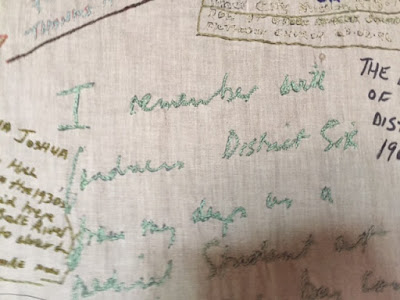 |
| Steve Biko .....art work within the Langa township |
So.....how did I not know about District 6 ?
My recent trip to South Africa has been an incredible experience. I'm sure I will be blogging about cricket, flora and fauna, animals and spectacular scenery in the next few weeks. However, today, I want to record some thoughts and images related to the political background to what I have now, personally witnessed. It has been a humbling experience.
"District 6" was the 6th Municipal district of Cape Town, established in 1867. It was a racially mixed suburb of freed slaves, merchants, artisans, labourers and immigrants. It was a vibrant and close knit community where tolerance and freedom were central.
 |
| Photo from the District 6 Museum, showing the area before it was bulldozed flat. |
This became more and more undesirable to the apartheid government, so there was a plan to demolish all the buildings in the area and declare it a whites only district.
 |
| This is what District 6 looks like now......flattened, but empty....the planned white suburb never happened. |
Between 1966 and 1982, the entire area was bull dozed. More than 60,000 people were forcibly removed, to areas like the Langa and Nyanga townships.
 |
| A scene from Langa, one of the Cape Town townships. The irony of the billboard was particularly haunting. |
Incredibly enough, once the place was cleared......no one was prepared to move in. What was a vibrant and thriving community remains a patch of derelict wasteland today. The feeling now is that it should remain as such, as a reminder of the forcible removal of all those people. There is now a museum which is documenting what happened and is a place for those people whose homes were destroyed and lives wrecked, to record their thoughts about what happened.
 |
| District 6 now. |
One of the most haunting museum exhibits I have ever seen is the " namecloth".
It started as a narrow strip of calico, that ex residents of District 6 were invited to write on, recording something of their District 6 memories. Pens were provided, and hundreds of people started writing their thoughts on the sheet. Some women then had the idea of embroidering over the writing, and the namecloth began. It now measures over a kilometre long, and contains thousands of inscriptions.
Since 1999 women inmates from Pollsmoor Prison have been involved, along with other sewing groups, ensuring that the inscriptions are recorded permanently.
 |
| "I remember District 6 with fondness.. " |
 |
| " My very best years was in District 6 " |
 |
| " A completed piece to my own personal jigsaw of life" |
 |
| "I would like to come back" |
Learning about District 6, visiting Langa, and talking to people about the changes, and the slow rate of those changes, since Democracy, has been a very moving and powerful experience.
The beauty of this country, the animals, the birds, the plants, the scenery....the cricket.....have all been seen with us recognising the dreadful history of what people in this country have been through......and it is not over yet.
 |
| A Langa resident, today.......explaining how she burns the fur from sheeps heads, the cheapest meat she can buy. |



